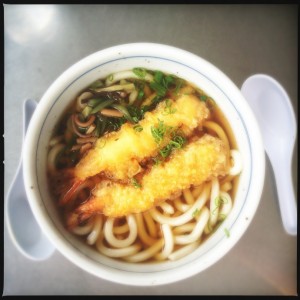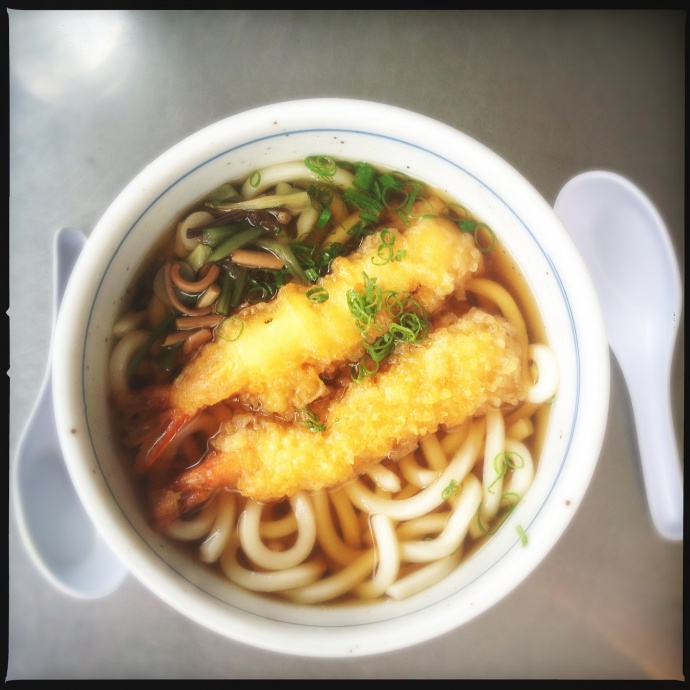Kojima’s Sushi Bar: Expanding Upcountry Dining Options (MauiNow.com)
 If you’ve ever had tempura udon soup, you probably want more.
If you’ve ever had tempura udon soup, you probably want more.
Nestled in a little strip mall on Makawao Avenue in Pukalani, the recently opened Kojima’s Sushi Bar regularly offers the savory soup on the specials board.
A former employee at Isana, Cafe O’ Lei, and Sansei, chef and owner Sadao Kojima has made this a family affair: his daughter waits the tables.
Lunch is available Tuesday to Friday from 11 a.m. to 2 p.m. and dinner is offered Tuesday to Sunday from 5 p.m. to 9 p.m.
We arrived a little after 1 p.m., and there were two other tables – a total of seven diners – already there. We were quickly seated and provided with water, but that’s when the momentum stopped. It was more than 30 minutes before the Seaweed Salad ($4.50) appeared. The salad itself was tasty and very traditional: seaweed, sesame oil, and a sesame seed garnish. Although a rather small portion, it had a pleasing fresh taste and crunchier texture than the typical grocery store offering.
Almost immediately thereafter, the Tempura Udon off the specials board ($9.50) arrived. The waitress warned that the bowl was too hot to touch, and the soup itself followed suit. Unfortunately, the tempura-fried shrimp were already floating in the broth and were completely soaked through. The formerly crispy coating fell off into the bowl when the shrimp was lifted by chopsticks.
Consider ordering the Tempura Udon with the shrimp on the side, but definitely order it, because the soup is stellar. The dashi-based broth was excellent, replete with thick, chewy udon noodles, green onions and sansei or “mountain vegetables.” Originally, mountain vegetables referred to fern shoots and similar plants foraged in the wild, although most are farm-raised these days. They were a unique touch and made for an interesting and delicious embellishment.
It seems that the chef prepares all the dishes for each individual table in one fell swoop. This restricted the waitress’s ability to time the service. We went from starving to sudden overload, as the entire order was crowded onto the tiny table all at once.
The Negi Hama ($8) – or hamachi and green onion maki roll – was light and refreshing. The hamachi was fine-chopped (a la a spicy roll), but still fresh-tasting and well-complimented by the cucumber and green onion inside. Sushi is all about the rice, and great fish can arguably be ruined by a bad batch. Sushi rice should be shiny and have a slightly tart/sweet taste: Chef Kojima’s was on the money.
Maui Now also tried the Hawaiian roll ($8.50). Filled with maguro (ahi), cucumber, and avocado and coated with sesame seeds, it provided a tasty bite. The ahi seemed very fresh, but had an inconsistent cut size. Some rolls had a giant portion of fish, while others had almost none. One was left wondering if perhaps pieces chopped for use in the poke were used in the roll, as that might explain the notable irregularity.
Although it is entirely possible for one person to do all the cooking for a Japanese restaurant (see the beloved Koiso in Kihei as a case in point), usually there is a limit to how many people can be effectively served. Koiso features an eleven-seat sushi bar and one four-person table for a maximum of 15 diners.
In sharp contrast, Kojima’s offers seating for 66. Considering it took half an hour before a single item of food appeared on a slow weekday afternoon, one is humbled imagining how long the wait might be if even half of those 66 seats were occupied with hungry diners: daunting is an understatement. The chutzpah of a one man show is admirable and the food itself was good, so one is left hoping Chef Kojima might hire some additional chefs soon so that his namesake restaurant can deliver top-notch quality on all fronts.






